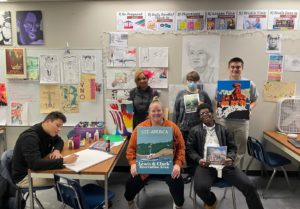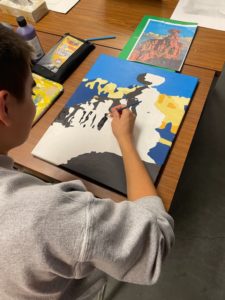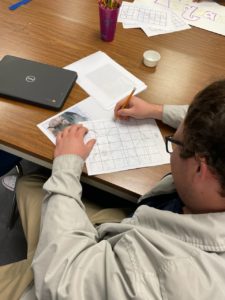
Bright oranges, reds and yellows create a striking rendition of the Mexican Hat rock in southeast Utah’s Monument Valley. Summit Academy – Toledo senior Marcos Dominguez painted a poster of the iconic stone, which resembles a Mexican sombrero, in a style patterned after the WPA (Work Projects Administration) National Parks posters. Situated against a brilliant blue-sky backdrop and accented with brown crevices, shadows and other intricate details, Dominguez’s Mexican Hat reflects the minimalist approach to art symbolic of the popular WPA travel posters of the mid-1930s and early 1940s, art teacher Ashley Deuschle describes.
Although Dominguez says he has always enjoyed drawing he never truly explored it until now, at Summit Academy during this, his senior and first year at the school. While Dominguez has his future sights set on becoming a veterinary technician, he says he will probably maintain art as a recreation.

“I haven’t really done that much art until now,” Dominguez says. “I have always liked to draw but never really had gotten into it. I’ll probably continue it as a hobby.”
Deuschle’s idea to engage her students in the poster project “was inspired by my visits to my parent’s home in Yankton, South Dakota where we explore the bluffs and parks along the Missouri River,” she says. “Going outdoors and appreciating the scenery is important to my dad and the painting I made to demonstrate the project is from a photo I took of the bluffs of the Lewis and Clark Recreation Area in Yankton where he takes us exploring the waterways.”
While the poster project gives students an opportunity to learn about natural sites, it also has an applied art spin, opening students’ eyes to possibilities of an art career focused on travel, digital or even entrepreneurial industries. “For the travel industry, posters inspire people to visit parks and other destinations,” says Deuschle. She adds that art, in the conventional sense, such as in painting and drawing, is not the only option. “Manipulating a graphic design program can be very inspirational and lead to opportunities in selling pieces in Etsy shops as well.”
As her seniors are entrenched in painting posters of inviting destinations such as Niagara Falls, Zion National Park and White Sands National Park, Deuschle’s juniors have been trying their hand at scientific illustration.

Using a grid technique, the students are creating drawings of animals from four perspectives. For instance, one of Deuschle’s students, Mason Rhodes, sketched a full-body image of a wolf in a stance ready to stalk prey, another of its skull, a side view of its face and, for the fourth perspective, one of its claw, quarter-size.
For the scientific illustration assignment, students are not limited to sketching images of existing animals. Some have opted for plants while others chose prehistoric animals or fantasy creatures for their subjects.
“I don’t want to limit them,” says Deuschle, who has taught at Summit Academy – Toledo for the past decade and enjoys keeping her lessons relevant and interesting. “It’s way more fun if they are invested in it.”
Deuschle’s students in ninth and 10th grades are working on equally creative projects. Her ninth graders are drawing koi fish, cherry blossoms, dragons and anime characters as they study Japanese culture and art. Meanwhile, her sophomores are delving into early Irish and Norse folklore and art. The projects usually never focus exclusively on art, but instead, are cross-curricular in nature.
“I’m consistently amazed by how incredibly creative, hard working and artistic our students are,” Deuschle says. “Meanwhile, they are learning about anatomy, nature, geology and other cultures.”
